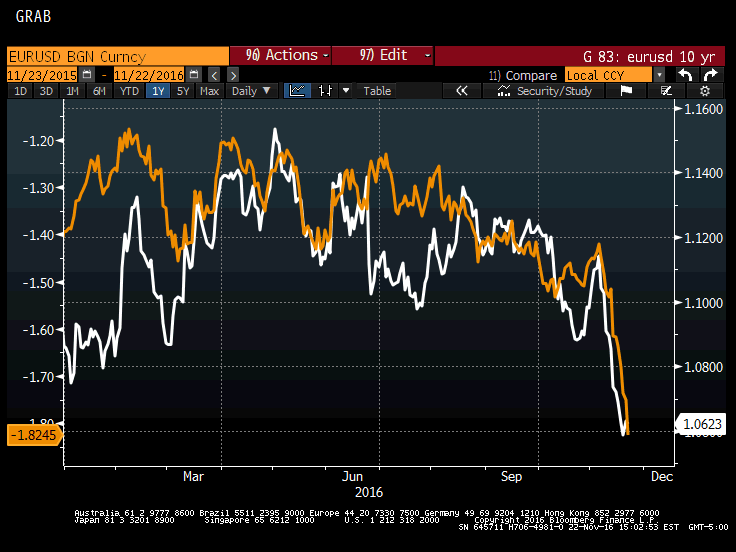By Kathy Lien, Managing Director of FX Strategy for BK Asset Management.
Don’t be mistaken by the mixed performance of Tuesday's U.S. dollar because dollar bulls remain in control. Dips in the greenback have been shallow with the dollar making a run for its 6-month high versus the Japanese yen and hitting a fresh 9-month high against the Swiss franc. We’ve seen very little profit taking in the EUR/USD, USD/JPY and USD/CHF outside of the steep slide in USD/JPY after reports of an earthquake and tsunami. U.S. Treasury yields have pulled back, but not by much. And more importantly, yield spreads continue to favor the dollar. For example, while 10-year Treasuries dropped 1bp on Tuesday, German bund rates fell 5bp, pushing the German-US Treasury yield spread to a fresh 16-year low. U.K. gilt yields also tumbled, dragging GBP/USD lower. The Richmond Fed manufacturing index and existing homes surprised to the upside, lending support to the greenback. While these numbers have minimal impact on Fed policy, positive data gave investors the perfect excuse to continue driving the dollar higher. USD/JPY clearly wants to make a run for 112 and the upcoming Thanksgiving Day holiday in the U.S. may not stop the currency pair from trying. In fact at this stage, the decrease in liquidity over the next few days could create the perfect environment for a quick run for 112. Profit taking is still possible but the currency pair’s general strength makes a move to 110 before a rise to 112 less likely. The Fed minutes, durable goods orders, weekly jobless claims, new home sales, Markit Economics’ Manufacturing PMI report and revisions to the University of Michigan consumer sentiment index are scheduled for release Wednesday. None of these reports will materially affect the market’s expectations for December tightening and once the FOMC minutes are released, liquidity will start to dip off as U.S. traders leave early for a 4-day weekend.
The euro ended the day virtually unchanged against the greenback, leaving investors wondering whether the consolidation will turn into a bottom or the move is simply a pause before further losses. In Monday’s note, we listed 5 reasons why we believe EUR/USD is headed for 1.05. One of which is slow growth, which should be evident in Wednesday’s PMI reports. Tuesday’s Eurozone consumer confidence number was slightly better than expected but the improvement from -8 to -6.1 was far from impressive. Instead, EUR/USD traders should keep an eye on the following chart, which has the yield spread (yellow line) signaling further losses in EUR/USD (white line).
Tuesday's worst-performing currency was the British pound. Public sector finances were better than expected but sterling traders ignored the news, choosing instead to focus on Brexit. On Tuesday morning, EU negotiators said the window for Brexit is between 14 to 15 months, which is somewhat consistent with Prime Minister May’s plan to trigger Article 50 by March 2017 and exit the EU by March 2019. Sterling is in focus Wednesday with the Chancellor’s Autumn Budget Statement on the calendar. There’s hope that some type of spending program will be announced, but from what we’ve heard, that seems unlikely. If no new announcement is made in relation to lower taxes or more spending, sterling could fall in disappointment. If a fresh stimulus package is unveiled, GBP could soar.
It was a mixed day for the commodity currencies with the Australian dollar trading higher while the Canadian and New Zealand dollars moved lower. AUD was lifted by copper prices, which rose to a 1-year high and upbeat comments by RBA Assistant Governor Christopher Kent. Kent said he sees reasonable prospects for improvement in the mining states. In turn, with the mining states showing improvement, prospects for economic growth for the country as a whole also increased and a gradual return of inflation to more normal levels is to be expected. Kent also mentioned that he did not want to see wage growth slow any further, noting that the 1.9% increase in wages was due mainly to Western Australia and the decline in demand conditions for the region. The decline in full-time employment continues to be of concern, even in light of a falling unemployment rate. Overall, his message was viewed as mildly hawkish. On the other hand, RBNZ Bascand said recent consumer behavior has affected the country’s inflation forecasts. Although there is evidence that suggests consumers have become more careful with their spending habits, the suggestion of secular stagnation is not as warranted as other advanced countries. He expects to see per-capita consumption increase over time. New Zealand as a whole is working through a prolonged but temporary debt overhang. Lastly, OPEC worries continued to drive the Canadian Dollar. Oil fell slightly as worries about a deal next week remain. No economic reports are scheduled for release from Canada on Wednesday.

